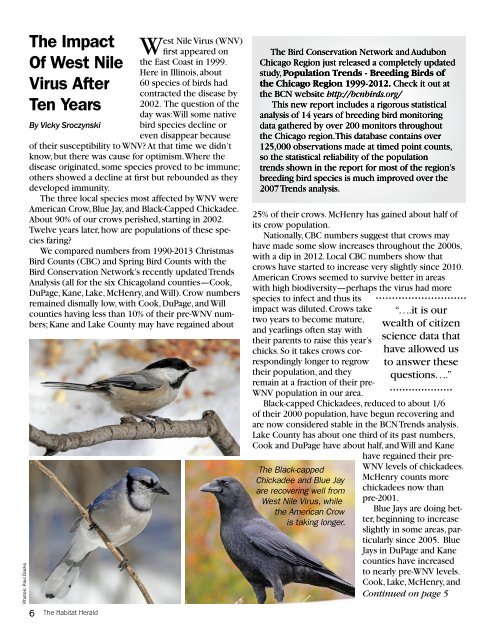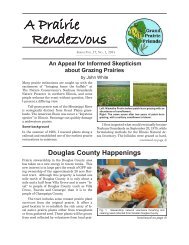Photos: Paul DackoThe ImpactOf West NileVirus AfterTen YearsBy Vicky SroczynskiWest Nile Virus (WNV)first appeared onthe East Coast in 1999.Here in Illinois, about60 species of birds hadcontracted the disease by2002. The question of theday was: Will some nativebird species decline oreven disappear becauseof their susceptibility to WNV? At that time we didn’tknow, but there was cause for optimism. Where thedisease originated, some species proved to be immune;others showed a decline at first but rebounded as theydeveloped immunity.The three local species most affected by WNV wereAmerican Crow, Blue Jay, and Black-Capped Chickadee.About 90% of our crows perished, starting in 2002.Twelve years later, how are populations of these speciesfaring?We compared numbers from 1990-2013 ChristmasBird Counts (CBC) and Spring Bird Counts with theBird Conservation Network’s recently updated TrendsAnalysis (all for the six Chicagoland counties—Cook,DuPage, Kane, Lake, McHenry, and Will). Crow numbersremained dismally low, with Cook, DuPage, and Willcounties having less than 10% of their pre-WNV numbers;Kane and Lake County may have regained aboutThe Bird Conservation Network and AudubonChicago Region just released a completely updatedstudy, Population Trends - Breeding Birds ofthe Chicago Region 1999-2012. Check it out atthe BCN website http://bcnbirds.org/This new report includes a rigorous statisticalanalysis of 14 years of breeding bird monitoringdata gathered by over 200 monitors throughoutthe Chicago region. This database contains over125,000 observations made at timed point counts,so the statistical reliability of the populationtrends shown in the report for most of the region’sbreeding bird species is much improved over the2007 Trends analysis.25% of their crows. McHenry has gained about half ofits crow population.Nationally, CBC numbers suggest that crows mayhave made some slow increases throughout the 2000s,with a dip in 2012. Local CBC numbers show thatcrows have started to increase very slightly since 2010.American Crows seemed to survive better in areaswith high biodiversity—perhaps the virus had morespecies to infect and thus itsimpact was diluted. Crows take “….it is ourtwo years to become mature, wealth of citizenand yearlings often stay withtheir parents to raise this year’s science data thatchicks. So it takes crows correspondinglylonger to regrow to answer thesehave allowed ustheir population, and they questions….”remain at a fraction of their pre-WNV population in our area.Black-capped Chickadees, reduced to about 1/6of their 2000 population, have begun recovering andare now considered stable in the BCN Trends analysis.Lake County has about one third of its past numbers,Cook and DuPage have about half, and Will and Kanehave regained their pre-WNV levels of chickadees.McHenry counts morechickadees now thanpre-2001.Blue Jays are doing better,beginning to increaseslightly in some areas, particularlysince 2005. BlueJays in DuPage and Kanecounties have increasedto nearly pre-WNV levels.Cook, Lake, McHenry, andContinued on page 56 The Habitat Herald
Management Helps Rare PlantsBy Anna BraumSuccess stories involving threatened plant species areoften in short supply, but one species native to theChicago region has recently undergone a surprisingresurgence at sites where it is monitored in McHenryCounty. Triglochin maritima, also known as commonbog arrowgrass, is a species that manyplant lovers may not have encountered intheir local nature preserves. This is partiallydue to its status as a state-listed speciesthat has a limited distribution throughoutIllinois. The species also has particularhabitat preferences, growing in restrictedareas such as calcareous pannes (wet, interdunalflats), marshes, wet meadows andfens. These habitats are likewise hospitableto many other rare plant species, such as purple falsefoxglove (Agalinis purpurea) and fringed gentians(Gentianopsis crinita), which grow in association withbog arrowgrass.Bog arrowgrass is one of 249 species monitoredby the Chicago Botanic Garden’s Plants of ConcernProgram (POC), a regional monitoring program thatrelies on volunteers to collect data on regional rare,threatened, and endangered plant populations. Thesedata are collected along with information pertaining tosite management activities, as well as data that quantifythreats to the populations from sources such as invasivespecies. POC monitors bog arrowgrass at eightsites throughout the Chicago Wilderness Region, whereit flowers in late May through September. During thisperiod, it can be identified by a raceme of white tuftedflowers, followed by the appearance of cylindrical seedcapsules. Less readily discernible is the cyanide presentin its fleshy, grass-like leaves, which discourages potentialherbivores.Lyn Campbell has been a volunteer monitor for thePOC program since 2012 and monitors two threatenedspecies, including bog arrowgrass and the northerngreen orchid (Platanthera hyperborea var. huronensis)in McHenry County. She is also actively involvedwith the County’s plant phenology monitoring andseed collection programs. As a POC monitor, she trackschanges in plant population size from year to year, andrecently noted a “big jump” in bog arrowgrass populations.One population increased from zero floweringstems in 2011 to 16 flowering stems in 2013. A secondpopulation that consisted of 50 flowering stems in2011 had also grown considerably by 2013, reachinga total of 164 flowering stems. The latter count representsthe largest recorded number of flowering stems“….this dramaticpopulationgrowth….maybe attributableto prescribedburns….”for bog arrowgrass in McHenry County since POCbegan monitoring the species there in 20<strong>04</strong>.What factors could be responsible for this dramaticpopulation growth? According to Laurie Ryan, a plantecologist with the McHenry County ConservationDistrict, it may be attributable to prescribedburns that the county conducted each yearprior to the observed population increases.By removing accumulated thatch and exposingseeds to sunlight, these burns are likelyto have stimulated germination, one of thepositive outcomes for many native plant speciesassociated with this management practice.A carefully timed schedule of prescribedburns may also help to curtail the growth ofinvasive species such as reed canarygrass (Phalarisarundinacea), a species that Lyn Campbell identifiedas particularly problematic in the areas she monitors.Bog arrowgrass is just one example of an imperiledspecies that has benefited from the collaborative effortsof POC monitors and land management agencies, linkingregional data collection with management strategiesthat promote the continued survival of rare plantsand the ecological integrityof their specializedhabitats.If you would likemore informationabout becoming involvedwith the Plantsof Concern program,please visit: http://www.plantsofconcern.org. Additionally, detailsabout the manyvolunteer opportunitiesoffered throughthe McHenry CountyConservation Districtare available at: http://www.mccdistrict.org.Bog arrowgrass isdoing better at oneMcHenry Countysite, thanks to goodmanagement andgood monitoring.<strong>Apr</strong>il <strong>2014</strong> 7Photo: Carol Freeman



